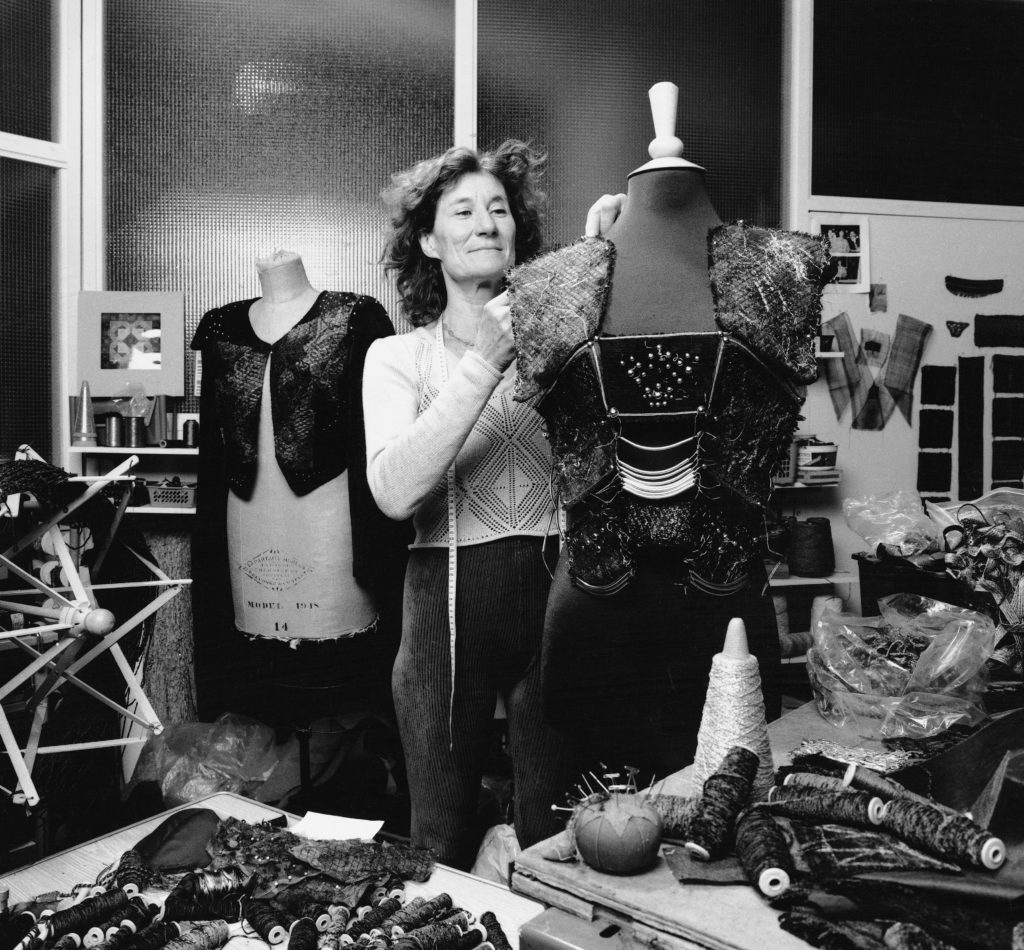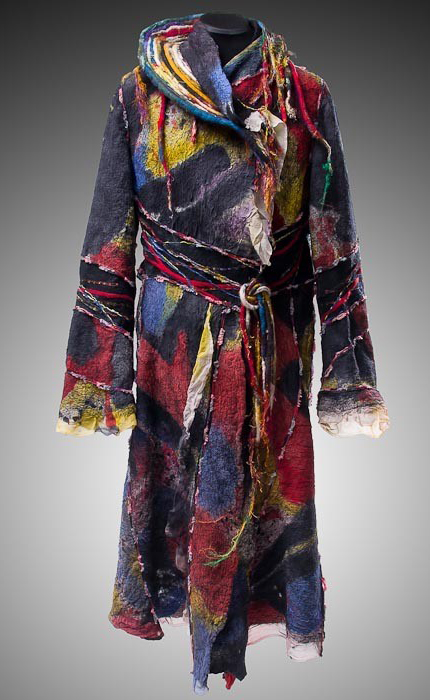
Rosie Godbout © François Renaud. Photo courtesy of Rosie Godbout
After immigrating to Canada in 1966, Rosie Godbout taught physical education for several years in Montreal before moving out to the country in 1978 to start teaching herself how to create textile art.
Though the fashion of the day was to use raw materials, unbleached fibres and robust textures, Rosie Godbout’s creations stood out for their bright colours and sophisticated compositions of contrasts and tones.
Her figurative pieces, which could depict a landscape, for example, broke from the weaving conventions of the time, which generally excluded any imagery. Starting in 1979, she created eye-catching garments that were presented at events like the annual Salon des métiers d’arts exhibition/sale in Montreal. In 1984, Rosie Godbout moved back into the city and set up an atelier on Mont-Royal Avenue, where she entered a period of creativity and growth that culminated in her first grand prize from the Quebec Craft Council in 1986. On a trip to Corsica and Senegal in 1993, she had an opportunity to reflect on her personal origins and on cultural differences, even within the Americas. The outcome of this reflection was a work entitled Métissage, a remarkable exploration of the adornment aspect of clothing, which was justly rewarded with a second grand prize from the Quebec Craft Council in 1993.
In the early 1980s, she experimented with dyeing fibres and created a broader palette of colours that continued to evolve along with other aspects of her work. Over time, this palette became darker, more nuanced, and more subtle. From the very beginning of her practice, materials and textures were very important to the artist.
For example, she experimented with brushed mohair yarn in an attempt to achieve a wider variety of textures.
After discovering chenille around the mid-1980s, she made it her yarn of choice for many years.
Rosie Godbout constructs and texturizes her materials in a series of treatments or successive steps. Starting with an idea, sometimes a drawing, each project evolves as it is being carried out. Used by the artist throughout her career, this method eventually led her to give up weaving and start creating garments in the 1990s, notably the piece Métissage (1993), the series for the exhibition Ornamentissimo (1997), and the striking tribute to family heritage entitled De Reine, à Aimée, à Rose-Marie (1998). Her process involves adding details to a base material, piecing together eclectic elements, and recycling fabric remnants.
It can also entail a variety of cumulative and complementary techniques, such as beadwork, embroidery, felting, topstitching, brocading and discharge printing.
With the help of additions, overlapping steps, and happy accidents, a piece acquires three-dimensionality not simply because of its architecture, which is designed to fit onto a body, but through its material, which achieves depth thanks to its layered composition.
Rosie Godbout’s wearable works of art have been shown in numerous exhibitions since 1984, notably in Toronto, Vancouver, the United States, Paris and Barcelona.
In October 2000, a retrospective of her work was presented in the exhibition Geneviève Sevin-Doering / Rosie Godbout. Formes et matières. Un vêtement autre at the Université du Québec à Montréal design centre. UQAM’s design centre also hosted her work as part of the Atmosphères exhibition in 2001. In 2006, a solo exhibition of her work was presented at the Canadian Guild of Crafts. Rosie Godbout has won numerous awards and honours in addition to the two grand prizes from the Quebec Craft Council in 1986 and 1993, as well as several creative development grants from the Conseil des arts et des lettres du Québec and the Canada Council. In addition to pursuing her art, she has taught at the Centre des métiers d’art en construction textile and sat on the board of the Conseil des arts textiles du Québec and the executive committee of the Quebec Craft Council. As of 2018, she was living and working in Saint-Armand in the Montérégie region.
Sources
Profil de l’artiste, ENOAC. External link
Baril, Gérald. «Rosie Godbout dans ses mots» et «Rosie Godbout. Matière et esprit du vêtement», dans G. Baril et al., Atmosphères, catalogue d’exposition, Montréal, Centre de design de l’Université du Québec à Montréal, 2000, p. 17-31.
Delisle, Michèle. «D’alchimie et d’intuition», dans G. Baril et al., Atmosphères, catalogue d’exposition, Montréal, Centre de design de l’Université du Québec à Montréal, 2000, p. 14.
Dufault, Mylène. «Dossier. Les métiers d’art du textile. Rosie Godbout», Magazine des métiers d’art, vol. 10, no 3, October 1997, p. 30-33.
Gauthier, Jean-Louis. «Rosie Godbout, entre le tissage et la haute couture», Châtelaine, vol. 27, no 12, December 1986, p. 9-10.
Roy, Louise. «Rosie Godbout, ou le plaisir de la vie», dans G. Baril et al., Atmosphères, catalogue d’exposition, Montréal, Centre de design de l’Université du Québec à Montréal, 2000, p. 15.
Publication date
01/10/2004
Writing
Dicomode
Revision
Madeleine Goubau, Contributor
Share
DownloadRecommended entries
© MCCORD STEWART MUSEUM 2025







